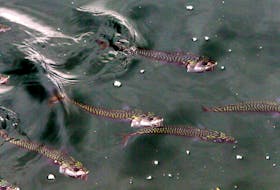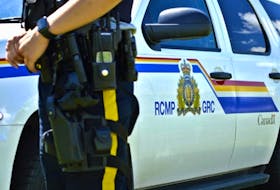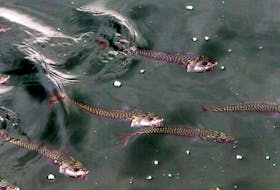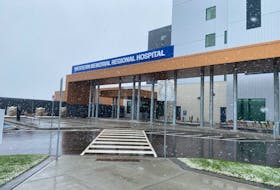After four months the day had come to harvest the canola field that Kavanagh, alternative feeds co-ordinator with the Forestry and Agrifoods Agency, has been overseeing.
“It’s just wonderful,” she said as the harvester pulled the pods from the plants and separated out the canola seeds. “This was a really big test for us.”
While the quality analysis has yet to be completed, Kavanagh didn’t hesitate to call it a success.
Kavanagh worked with canola on the mainland and in university and knew it was a crop that could grow here. She said the province had the heat units needed and the land. What was lacking was a rotation system that would be high value crops in terms of economics and feed value.
Kavanagh said some of the highest value available comes in grains and the province imports 63,000 metric tonnes of grains a year. It also doesn’t grow any oil seeds.
By being able produce canola here, Kavanagh said it could result in a savings on importing, increase feed and food security and increase the capital value of farms.
The seeds gathered in the harvest will go to Hammond Farm to be put through a mechanical press to push out all the oil. The leftover particles from the process, the highly nutritious meal, will be distributed to Pure Holsteins to be fed to their cows.
Hammond Farm will also provide the canola oil, which is considered a byproduct of the project, on a trial basis to two local restaurants. The oil will be fully tested to ensure it is food grade and food safe.
The nutty flavour of the oil is amazing, she said.
As for the possibility of one day seeing it on a shelf somewhere, Kavanagh said there’s no reason to think it won’t get there.
She said there are so many applications for the canola oil from home use and personal consumption to restaurants, infused oils and even fuel.
The plant waste from the harvest can be left in the field as a source of organic matter or ground up and used as bedding for animals.
Kavanagh said the canola will be tested again next year in Cormack and the fields in Pasadena will be planted with spring wheat. She said it was important to know this is a crop that will be viable on the long-term and not just over the one year.
Twitter: @WS_DianeCrocker
By the numbers
25 — Yield of about 25 tonnes of canola seeds and 30,000 litres of canola oil.
28 — A total of 28 acres planted over two fields.
3,000 — Number of 1-litre bottles of canola oil that can be produced.
Harvesting the future?
Taking a step into the future of agriculture in Newfoundland and Labrador was achieved Friday morning when the province’s first canola harvest took place at the Agriculture Research Station in Pynn’s Brook, near Pasadena.
The 30-acre crop yield will help inform future activities and contribute to an increasingly innovative agriculture industry in this province.
"The canola that was planted this past spring grew exceptionally well, surpassing our researcher’s expectations,” Minister of Fisheries, Forestry and Agrifoods Steve Crocker stated in a news release. “This harvest has been a priority for our department because it is helping to grow the agriculture industry. This in turn will facilitate food security by advising producers on crop and livestock systems in order to maximize production in a sustainable manner.”
Canola is Canada’s second most important revenue generator behind wheat. It is grown in nine Canadian provinces and worth over $19 billion to the Canadian economy.
The Newfoundland and Labrador agriculture industry provides about 6,500 jobs and has primary and value-added production worth approximately $500 million. The provincial government provides $1 million to continue agricultural research and development.
After four months the day had come to harvest the canola field that Kavanagh, alternative feeds co-ordinator with the Forestry and Agrifoods Agency, has been overseeing.
“It’s just wonderful,” she said as the harvester pulled the pods from the plants and separated out the canola seeds. “This was a really big test for us.”
While the quality analysis has yet to be completed, Kavanagh didn’t hesitate to call it a success.
Kavanagh worked with canola on the mainland and in university and knew it was a crop that could grow here. She said the province had the heat units needed and the land. What was lacking was a rotation system that would be high value crops in terms of economics and feed value.
Kavanagh said some of the highest value available comes in grains and the province imports 63,000 metric tonnes of grains a year. It also doesn’t grow any oil seeds.
By being able produce canola here, Kavanagh said it could result in a savings on importing, increase feed and food security and increase the capital value of farms.
The seeds gathered in the harvest will go to Hammond Farm to be put through a mechanical press to push out all the oil. The leftover particles from the process, the highly nutritious meal, will be distributed to Pure Holsteins to be fed to their cows.
Hammond Farm will also provide the canola oil, which is considered a byproduct of the project, on a trial basis to two local restaurants. The oil will be fully tested to ensure it is food grade and food safe.
The nutty flavour of the oil is amazing, she said.
As for the possibility of one day seeing it on a shelf somewhere, Kavanagh said there’s no reason to think it won’t get there.
She said there are so many applications for the canola oil from home use and personal consumption to restaurants, infused oils and even fuel.
The plant waste from the harvest can be left in the field as a source of organic matter or ground up and used as bedding for animals.
Kavanagh said the canola will be tested again next year in Cormack and the fields in Pasadena will be planted with spring wheat. She said it was important to know this is a crop that will be viable on the long-term and not just over the one year.
Twitter: @WS_DianeCrocker
By the numbers
25 — Yield of about 25 tonnes of canola seeds and 30,000 litres of canola oil.
28 — A total of 28 acres planted over two fields.
3,000 — Number of 1-litre bottles of canola oil that can be produced.
Harvesting the future?
Taking a step into the future of agriculture in Newfoundland and Labrador was achieved Friday morning when the province’s first canola harvest took place at the Agriculture Research Station in Pynn’s Brook, near Pasadena.
The 30-acre crop yield will help inform future activities and contribute to an increasingly innovative agriculture industry in this province.
"The canola that was planted this past spring grew exceptionally well, surpassing our researcher’s expectations,” Minister of Fisheries, Forestry and Agrifoods Steve Crocker stated in a news release. “This harvest has been a priority for our department because it is helping to grow the agriculture industry. This in turn will facilitate food security by advising producers on crop and livestock systems in order to maximize production in a sustainable manner.”
Canola is Canada’s second most important revenue generator behind wheat. It is grown in nine Canadian provinces and worth over $19 billion to the Canadian economy.
The Newfoundland and Labrador agriculture industry provides about 6,500 jobs and has primary and value-added production worth approximately $500 million. The provincial government provides $1 million to continue agricultural research and development.








